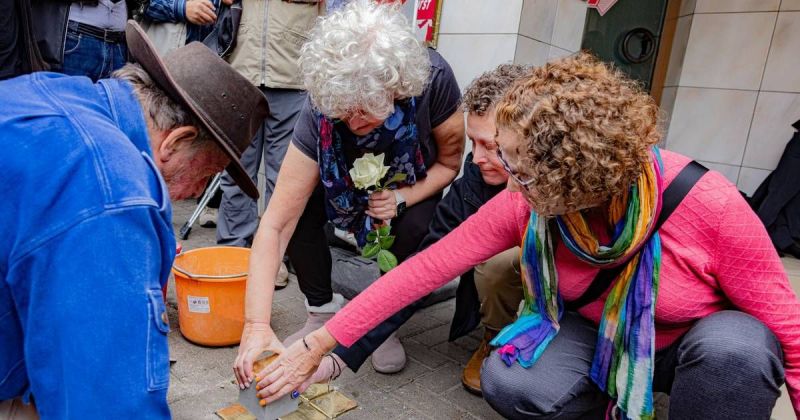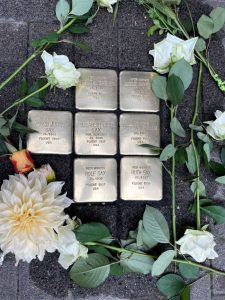
are sisters Lori Levin (left), Terri Pazornick (middle) and Randi Malamphy (right, pink shirt), with German artist Gunter Demnig (blue shirt), Oct. 11, 2022. (Courtesy)
Three sisters who grew up in Baltimore knew little about their mother fleeing Nazi Germany as a toddler. But an unexpected call from a German city archivist — three months after their mother died — persuaded the sisters to travel to Germany to learn more about Ruth Sax Levin’s fate and to seal her memory as part of the ongoing Stolpersteine project.
Stolpersteine, literally, a “stumbling stone,” are concrete blocks measuring four-by-four inches that are laid flush into the cobblestone sidewalk in front of the former homes of Jews who were murdered or had to flee Nazi terror in their neighborhood. Their names, birth year and fate (fled or perished) are hand engraved into a brass plate on the top of each stone.
On an October trip to Bornheim, Germany, sisters Randi Malamphy, Terri Pazornick and Lori Levin encountered the world’s largest decentralized monument to the Holocaust. The Stolpersteine immortalizes the memory of Jews and other victims who were persecuted and murdered by the Nazis between 1933 and 1945.
About 100,000 stones in 30 countries and in two-dozen languages have been laid in a grassroots memorial project started 30 years ago by German artist Gunter Demnig. At least 1,200 places in Germany have Stolpersteine installations.
Every year on Jan. 27, which is International Holocaust Remembrance Day, residents get on their knees to clean and polish the brass plaques in their neighborhoods. The Stolpersteine are also adorned with flowers and/or candles on the remembrance day that coincides with the anniversary of the liberation of Auschwitz-Birkenau extermination camp in Poland.
Bornheim archivist Jens Loeffler was researching the Sax family when he came upon Ruth’s online obituary. She died in Florida on April 14, 2022 at 85. She was only two in 1938 when the Scheuer and Sax families began fleeing their home in Bornheim on restrictive U.S. visas. The last family members made it out of Germany by May 1939 as Jewish persecution intensified and World War II was imminent.

Loeffler contacted the funeral home in Baltimore, Sol Levinson & Bros., and asked if they would reach out to the Sax daughters, all in their early 60s, on his behalf. Descendants of the former neighbors of the Sax and Scheurer family had contacted him about the fate of the family, emailed Loeffler. He wanted more information from Ruth’s descendants.
“We are actively searching for victims in our and other archives to research biographies on them,” he added. “We have had an installation every two years until now.”
Levin, a retired software trainer in Columbia, Md., was surprised to receive the call and thought it might be a scam. “But then we started looking into it and found out all about it, even downloaded the app,” she said.
Malamphy of Pompano Beach, Fla., was intrigued by the archivist’s inquiry. “We knew very little about that family history,” she said.
Soon after their encounter, Loeffler extended an invitation to the sisters for the installation on Oct. 11.
“The three of us thought we need to go, so we did a spur-of-the-moment trip to Germany for that,” said Levin.
‘The town was so welcoming’
Most survivors have died or are too elderly to participate in Stolpersteine installations, Loeffler wrote in an email. “Nowadays, it is the second and third generation that is interested in their family history and the fate of their grand- and great-grandparents. The Internet made it easier to make contact with them.”
It’s unusual for descendants to travel in for the laying of the stones; those who perished left no direct descendants. But this was the first time the town of Bornheim recognized a family forced to flee to the United States, said Pazornick of Columbia, Md., who is a training director for a nonprofit organization.
About 50 townspeople gathered for the afternoon installation on Bonner Strauss in front of a three-story building with a butcher shop at the ground level. Those in attendance included neighbors on the street; the mayor, who introduced the sisters in German and in English; and high school students working on a local history project about Stolpersteine. Local media turned out to report on the event.
The sisters placed in one hole the individual stones for their great-grandparents, grandparents, great-aunt, uncle and their mother, reported Pazornick. Someone in the community brought white flowers and the sisters laid them around the stones.
“Each person who lived there gets a stone because to say somebody’s name is to keep them alive,” said Levin, citing words from the Talmud. “It was beautiful. It made me cry. The town was so welcoming.”
“It was surreal and heartwarming, the whole experience,” said Malamphy, a retired special-education teacher from Ellicott City. “People came up to us and said, ‘I’m so sorry that this happened to your family.’ They said they’ll come by every week and make sure the stones stay clean.”
“This is a project that’s important to them,” added Pazornick.
‘It was like a gift from her’
Artist Demnig, who engraves the plaques, completed the installation of the Stolpersteine with several blows of a rubber mallet on the stones. “It was apparently a real honor for him to be there,” added Pazornick.
For a memorial keepsake, the sisters did a rubbing of the metal engravings on the blocks using onion-skin paper.
After the installation, the sisters were asked to speak to high school students at a local cafe.
“They interviewed us and then we were able to ask them questions,” said Malamphy. “It was very meaningful on top of what we had just experienced,” and especially important to talk with young people about it.
The Sax sisters were so moved by the Stolpersteine concept that they offered to pay it forward for the next family, said Malamphy. It costs $130 for hand-crafting and installation.
“They said so many people have given that they already have enough,” said Malamphy.
The sisters remarked how blessed they are that their mother, who had Alzheimer’s, passed away when she did. “They probably would not have found us if she hadn’t died because they were already researching my mom’s family,” said Malamphy.
Added Pazornick: “It was like a gift from her to us that we were able to see and experience a piece of her history.”
To learn more about the Stolpersteine project, visit: stolpersteine.eu.







